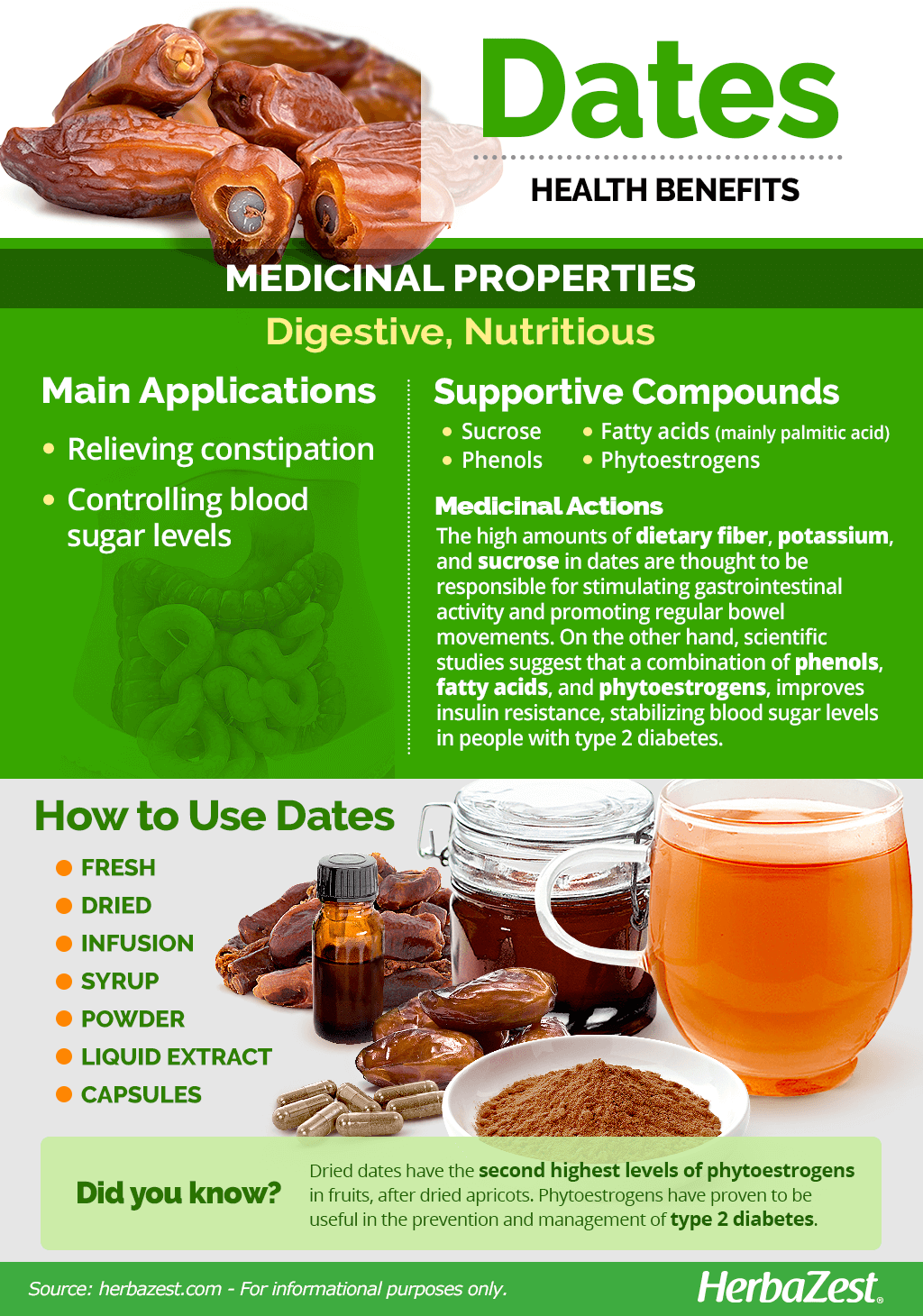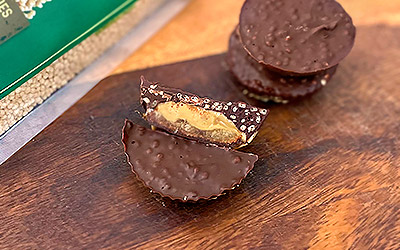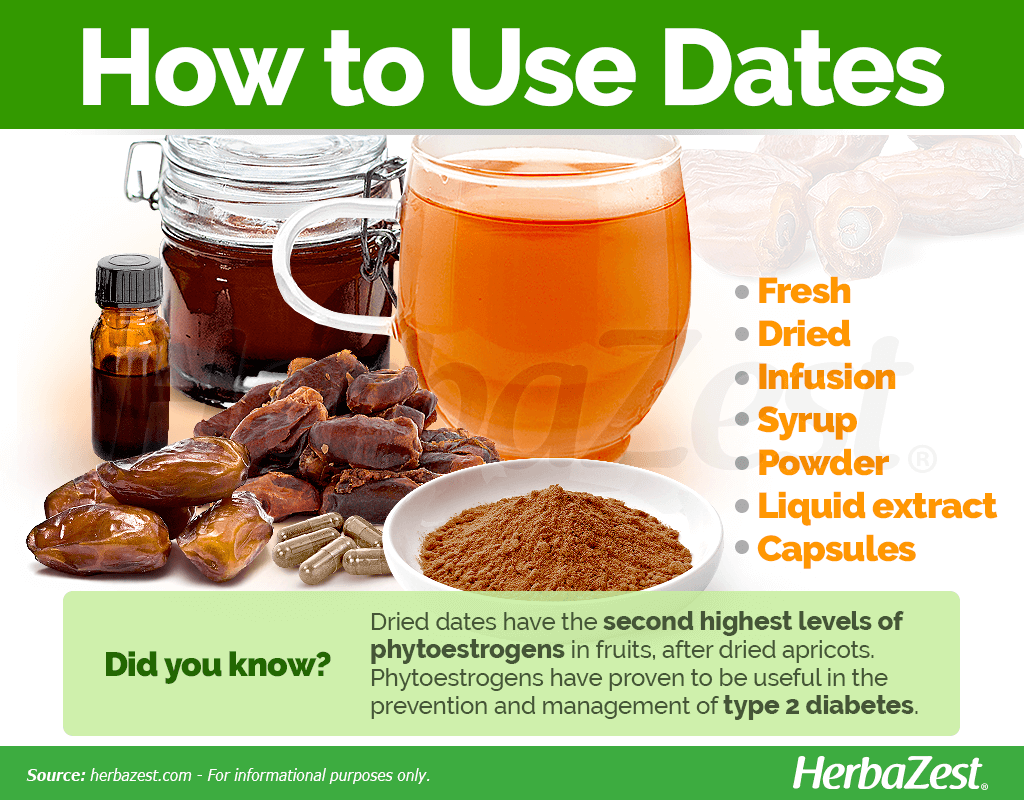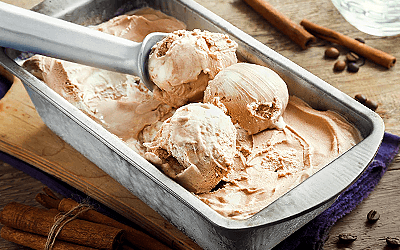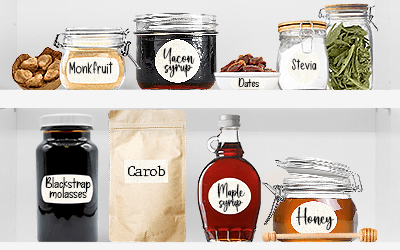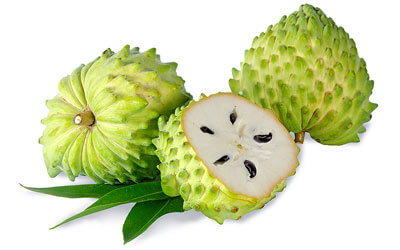The date palm tree is among the first crops cultivated by humans in what it is known as the cradle of civilization: Africa and the Middle East. In that region, dates are still a food staple and a popular ingredient in many traditional dishes. However, the relevance of the date fruit goes beyond its culinary uses. Numerous studies have been revealing the secrets and potential applications of dates for human health.
Date Medicinal Properties
- Medicinal action Digestive, Nutritious
- Key constituents Sucrose, phenols, fatty acids, phytoestrogens
- Ways to use Capsules, Hot infusions/tisanes, Liquid extracts, Powder, Syrup, Dried
- Medicinal rating (3) Reasonably useful plant
- Safety ranking Safe
Health Benefits of Dates
Dates, also known as khajur in India, are the fruits of the date palm and have been consumed with nutritional and medicinal purposes for millennia. Modern science revealed a number of dates' health benefits, with the following being the most relevant:
Relieving constipation. The date fruit is abundant in dietary fiber and other phytocompounds that work together to stimulate gastrointestinal function, ensuring smooth digestion and regular bowel movements.
Controlling blood sugar levels. This benefit may sound counterintuitive, given the sweet nature of dates; however, these dry fruits have proven to be effective in regulating glucose and insulin response in people with type 2 diabetes.
Additionally, different parts of the date palm have been traditionally used to treat a wide variety of health conditions. In folk medicine, the date fruit is prescribed for intestinal problems, sore throat, and respiratory conditions as well as for treating fever, cystitis, and edema.
How It Works
Besides the abundant presence of dietary fiber, there are many compounds that work together and are thought to be responsible for dates' health benefits, the main ones being sucrose, phenols, fatty acids, and phytoestrogens.
While the high amounts of sucrose in dates are often seen as a negative trait, this type of sugar, aided by the presence of potassium, is thought to be responsible for stimulating gastrointestinal activity, improving digestion. The liquid extract of dates have been shown to promote regular bowel movements, validating the traditional use of these dry fruits for relieving constipation.1
On the other hand, scientific studies suggest that a combination of phenols, fatty acids (sterols), and phytoestrogens improves insulin resistance, stabilizing blood sugar levels in people with type 2 diabetes.2
THE CONSUMPTION OF DATE FRUIT ALSO REDUCES SERUM TRIGLYCERIDE LEVELS IN INDIVIDUALS WITH HIGH CHOLESTEROL.3
Other herbs with digestive and laxative properties are pineapple and sweet potato, whereas figs and beans not only facilitate smooth digestion, but are also known for regulating blood sugar.
Dates Cautions and Side Effects
Dates are considered generally safe. However, when consumed in large amounts, dates can cause bloating and nausea.
Dates may also cause hypoglycemia in people with family history of a condition known as heredity fructose intolerance (HFI). Although rare, other symptoms may include sleepiness, excessive sweating, and shivering.
Most carbohydrates in the date fruit come from sugars, such as sucrose, glucose, and fructose. Individuals following a low fructose diet and those who suffer from fructose intolerance should avoid dates.

Date Nutrition
Dates are considered as a low glycemic index food, which don't significantly increases blood sugar in people with or without diabetes.
Dates not only provide a delicious flavor and sweetness, but are also a powerhouse of essential nutrients and a great source of dietary fiber.
In spite of their high content of carbohydrates (mostly sugars), dates provide an impressive variety of minerals. That includes copper, which plays a key role in the production and transport of red blood cells; and potassium, which is essential for fluid balance, muscle contractions, and proper functioning of the nervous system. Potassium also regulates blood pressure and prevents water retention. Moreover, good amounts of manganese contribute to healthy bones and help regulate inflammation as well as blood sugar levels.
Dates are a good source of B group vitamins, mainly B6 (pyridoxine) and B3 (niacin). Vitamin B6 is relevant for the metabolism of fats, proteins, and carbohydrates, as well as red blood cell and neurotransmitter production, whereas vitamin B3 helps transforming nutrients into energy, building and regenerating DNA, and protecting cellular integrity, all thanks to its antioxidant actions.
Additionally, dates provide small to adequate amounts of zinc, magnesium, calcium, and iron, along with vitamins B1 (thiamin), B2 (riboflavin), and B9 (folate).
100 GRAMS OF DRIED DATES PROVIDE 277 CALORIES, WHICH ARE MAINLY COMPOSED OF DIETARY FIBER (27% DV), CARBOHYDRATES (25%), AND PROTEIN (4% DV)
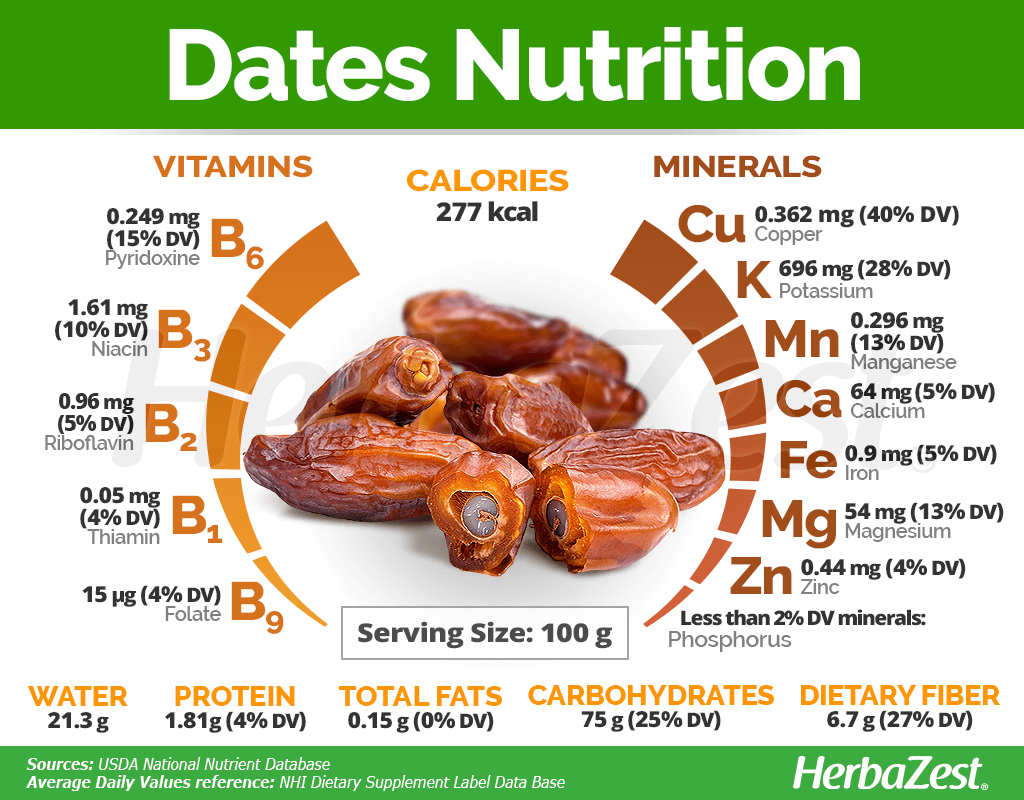
How to Consume Date
- Edible parts Fruit
- Edible uses Sweetener
- Taste Sweet
Natural forms
Fresh. Raw dates have pretty much the same amount of nutrients as dry dates; however, they provide a slightly lower amount of sugars and calories. Yellow-brownish in color, fresh dates have a shelf-life of 8-10 months.
Dried. Once dried, dates provide high levels of sugars and dietary fiber, beneficial for people with constipation and digestive issues. Properly stored, dry dates have a shelf-life of almost 5 years.
Syrup. The thick syrup obtained from ripe, dry dates is often used as a culinary flavor enhancer, healthy sweetener, mild laxative, and nutritional supplement.
Infusion. A warm infusion of dry dates can effectively aid digestion and facilitate bowel movements.
Powder. Date powder is rich in nutrients and often advertised as a healthy baby food since it can help with weight gain and early development as well as treating and preventing anemia.
Herbal Remedies & Supplements
Liquid extract. Some studies have suggested that date fruit and date palm liquid extracts can be effective for reducing triglycerides and harmful cholesterol levels as well as for improving gastrointestinal transit.
Capsules. Date fruit capsules provide standardized doses of bioactive components and are mainly consumed for constipation relief and as a digestive aid.
Growing
- Life cycle Perennial
- Harvested parts Leaves, Fruit
- Light requirements Full sun
- Soil Light (sandy), Loamy sand
The date palm, or date tree, is a perennial, mostly grown for its fruits. Outside of its native areas (the Persian Gulf, Africa, and the Middle East), it is cultivated in warm, arid regions of Australia, Mexico, South America, and the United States, especially in southern California, Arizona, and Texas. Given the right conditions of weather, soil, and light exposure, this palm, as well as its ornamental varieties, can be a great addition to a large garden or a landscape design.
Growing Guidelines
- Did you know?
For propagation purposes, two off shoots, or suckers, can be taken from a date palm annually for a period of 10 to 15 years.
The date plant is most commonly propagated by transplanting suckers, or off shoots, usually taken from the parent palm when they are 3 to 5 years old, with an average weight of 40 to 75 lbs (18-34 kg).
Date palm trees grow better in sandy to loamy sand soils as well as in clay and other heavy, well-drained soils, within a pH range of 6.0 to 8.0, acid to neutral.
The date palm prefers warm environments with full sun,and thrives at temperatures between 64-90°F (18-32°C); however, it can survive temperatures as low as 20°F (-7°C).
The date palm tolerates long dry spells; however, in order to optimize fruit bearing, it requires plenty of water, which in its native environment is provided by periodic river flooding and subterranean water rather than by rain.
The off shoots, trimmed in order to leave some of the stiff outer leaves to protect the inner ones, are usually planted 30-33 feet (9-10 m) apart, in holes 3 feet (0.9 m) wide and deep, enriched several months beforehand. In case the soil is dry at the moment of planting, the holes can be filled with water.
Date palms can be planted at any time of year, but the seedlings are usually transplanted in spring or fall, and they start blooming after 3 years, growing their first date fruits the next year. However, substantial crops will happen after 5 to 6 years. After the first 6 to 16 years, numerous suckers will grow around the base of the date palm.
Depending on the region where they are cultivated, date palms can be affected by a variety of plagues and diseases, some of them, like Fusarium albedinis, attacking the trunk, and others, like Manginiella scaeltae, causing decay of the inflorescences during the humid season. Date palm leaves, on the other hand, can be affected by fungus, such as pinhead spot, gray blight, and spongy white rot. The date fruit is often affected by moths and beetles, particularly during their ripe stage.
Additional Information
- Other uses Animal feed, Basketry, Cosmetics, Fuel
Plant Biology
The date palm (Phoenix dactylifera) is a dioecious perennial, monocotyledon fruit tree that can reach a height of 100 -120 feet (30.5-36.5 m). The trunk is completely covered with upward-pointing, overlapping, persistent, woody leaves. The green, feather-like leaves on top of the palm can be up to 20 feet (6 m) long and unassuming, fragrant flowers (whitish in female date palms and waxy to creamy on male ones) are borne in clusters from a branched spadix, which can reach up to 6 feet (1.8 m) long as the date fruits develop, slowly bending over due to the weight. The date fruit is oval shaped, 1-3 inches (2.5-7.5 cm) long, dark-brown, reddish, or yellowish-brown when ripe, with a thin skin, and thick, sweet flesh (astringent until fully ripe). The hard, single date seed is cylindrical, and slender, grooved down one side.
Classification
The common date palm (Phoenix dactylifera), belongs to the Arecaceae, or Palmae family, mostly known as the "palm family", which includes 2,500 species of woody shrubs, vines, and trees spread over 217 genera, mostly distributed in tropical, sub-tropical, and even warm temperate regions worldwide. This botanical family includes economically important species, such as coconut (Cocos nucifera), saw palmetto (Serenoa repens), acai (Euterpe oleracea) and aguaje (Mauritia flexuosa).
Varieties and Cultivars
Phoenix is a genus that includes about 14 species, which are native to the tropical or subtropical regions of southern Asia or Africa. However, because of its fleshy fruits, Phoenix dactylifera is the most commercially cultivated species, from which hundreds of cultivars have been developed.
Some of the most popular varieties of dates are: 'Barhi' (light amber to dark brown when ripe; soft, with thick flesh and rich flavor); 'Dayri' (these dates are long, slender, nearly black, and soft); 'Deglet Noor' (semi-dry, not very sweet; good shelf-life; mostly used for cooking); 'Halawy' (soft, extremely sweet, small to medium); 'Hayany' (dark-red to nearly black; soft); 'Khadrawy' (more popular in Iraq and Saudi Arabia, darker than American market varieties. Early-ripening, with short shelf-life); 'Khastawi' (small and popularly used for desserts; keeps well); 'Maktoom' (large, red-brown; thick-skinned, soft, mealy, medium sweet); 'Medjool' (marketed as a deluxe date in California; is large and soft); 'Saidy' (soft, very sweet); 'Sayer' (widely grown in Europe. Dark orange-brown, medium size, soft, and syrupy); 'Thoory' (brown-red with bluish bloom and a very wrinkled skin. The flesh is sometimes hard and brittle but the flavor is good, sweet and nutty);'Zahdi' (the oldest-known cultivar in the Middle East. Medium size, cylindrical, light golden-brown; semi-dry and very sugary).
History of Dates
The date palm is believed to have originated in the Persian Gulf, and in ancient times, it was especially abundant between the Nile and Euphrates rivers. There is an archeological evidence of date palm cultivation in eastern Arabia around 4,000 BCE. Nomads planted the date at oases in the deserts and Arabs introduced it to Spain, from where it spread to the rest of the world.
Popular Beliefs
Dates has been traditionally a staple food in Algeria, Morocco, Tunisia, Egypt, the Sudan, Arabia, and Iran, places where they were much revered and regarded as a symbol of fertility and depicted in bas relief and on coins.
Economic Data
Iraq has always led the world in date production, with 22 million date palms producing nearly 600,000 tons of dates annually.
Other Uses of Dates
Fodder. Date seeds are traditionally soaked in water and used to feed farm animals, such as camels, horses, sheep, goats, and cattle. Once dried and ground, dates are also food for chicken.
Cosmetics. Date seeds are a source of a yellow-green oil that it is used to make soaps and cosmetic products.
Construction. In North Africa, the leaves have been commonly used for making huts. The processed leaflets, combined with ground up peanut shells and corn cobs, are used for making insulating board. The trunk of the date palm is used for aqueducts, bridges, and various kinds of construction.
Crafts. Mature leaves are made into mats, screens, baskets, crates, and fans.
Fuel. All parts of the date three trunk are burned for fuel.
Sources
- Critical Reviews in Food Science and Nutrition, Date fruits (Phoenix dactylifera Linn): an emerging medicinal food, 2012
- Dates: Production, Processing, Food, and Medicinal Values
- Food and Agriculture Organization (FAO), Date Palm Products
- Frontiers in Plant Science, Date Palm Tree (Phoenix dactylifera L.): Natural Products and Therapeutic Options, 2017
- International Journal of Food Sciences and Nutrition, The fruit of the date palm: its possible use as the best food for the future?, 2003
- Journal of Family & Community Medicine, The unexpected truth about dates and hypoglycemia. 2016
- University of Virginia, Health System. Low Fructose Diet.
Footnotes:
- Journal of Medicinal Food. (2014). Effects of Dates Pulp Extract and Palm Sap (Phoenix dactylifera L.) on Gastrointestinal Transit Activity in Healthy Rats. Retrieved Jun 17, 2021 from https://www.ncbi.nlm.nih.gov/pmc/articles/PMC4098977/
- World Journal of Diabetes. (2015). Role of phytoestrogens in prevention and management of type 2 diabetes. Retrieved Jun 17, 2021 from https://www.ncbi.nlm.nih.gov/pmc/articles/PMC4360420/
- PLoS One. (2018). An extract from date palm fruit (Phoenix dactylifera) acts as a co-agonist ligand for the nuclear receptor FXR and differentially modulates FXR target-gene expression in vitro. Retrieved Jun 17, 2021 from https://www.ncbi.nlm.nih.gov/pmc/articles/PMC5749773/
